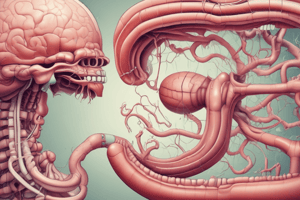Podcast
Questions and Answers
What is the shape of the stomach?
What is the shape of the stomach?
- Rectangular
- J-shaped (correct)
- Circular
- Triangular
Which part of the stomach stores incoming food?
Which part of the stomach stores incoming food?
- Body
- Pylorus
- Antrum
- Fundus (correct)
Which stomach section contains peristaltic contractions to mix food with gastric secretions?
Which stomach section contains peristaltic contractions to mix food with gastric secretions?
- Pylorus
- Body
- Antrum (correct)
- Fundus
What is the function of the pyloric sphincter?
What is the function of the pyloric sphincter?
How much does the stomach's internal surface cover in adults?
How much does the stomach's internal surface cover in adults?
What are the anterior and posterior sections of the stomach responsible for?
What are the anterior and posterior sections of the stomach responsible for?
Which layer of muscle in the stomach is responsible for breaking down food mechanically?
Which layer of muscle in the stomach is responsible for breaking down food mechanically?
What is the primary role of hydrochloric acid secreted by the stomach?
What is the primary role of hydrochloric acid secreted by the stomach?
What key function does the stomach perform in the digestive process by mixing food with gastric secretions?
What key function does the stomach perform in the digestive process by mixing food with gastric secretions?
In cases of gastrointestinal diseases, what might be required to manage symptoms effectively?
In cases of gastrointestinal diseases, what might be required to manage symptoms effectively?
Flashcards are hidden until you start studying
Study Notes
The Stomach: An Overview
The stomach is a crucial component of the gastrointestinal (GI) tract, responsible for breaking down food and preparing it for absorption. Located in the upper abdomen, the stomach is shaped like a J and is connected to the esophagus at the top and the small intestine at the bottom. Here's a closer look at the structure, function, and significance of the stomach.
Anatomy and Structure
The stomach measures approximately 25 cm in length and 5 cm in width, with its size varying based on the amount and recentness of a meal. Its internal surface covers around 3 square feet in adults. The stomach consists of five distinct sections: the fundus, the body, the antrum, the pylorus, and the lesser and greater curvatures.
Sections of the Stomach
Fundus
This section stores incoming food and acts as an expansible reservoir. It does not usually store food but can do so when the stomach is very full.
Body
This central and largest part of the stomach retains food until it is ready to move into the small intestine.
Antrum
The antral region contains strong wave-like muscle movements (peristaltic contractions) that mix food with gastric secretions, producing chyme - a thick, liquid mixture ready for further digestion.
Pylorus
The pyloric sphincter acts as a one-way valve, controlling the flow of chyme from the stomach into the small intestine.
Lesser and Greater Curvatures
These are the anterior and posterior sections of the stomach, respectively, responsible for distributing and storing food within the organ.
Muscle Layers
The stomach has several layers of muscle and other tissues: the oblique layer, middle circular layer, and external longitudinal layer. These muscles break down food mechanically. Additionally, the stomach secretes hydrochloric acid and enzymes like mucin, lipase, and trypsin, which help chemically digest food.
Functions of the Stomach
The primary functions of the stomach include:
- Storage: The stomach stores ingested food until it reaches optimal size for further digestion.
- Secretion: It secretes hydrochloric acid, which acts as a barrier against microorganisms and helps start protein digestion.
- Mechanical Breakdown: The stomach mixes food with gastric secretions, creating chyme.
Health and Disease
The stomach can be affected by various conditions such as gastrointestinal diseases, heartburn, constipation, abdominal pain, and others. Chronic conditions may require medical attention or lifestyle changes to manage symptoms effectively.
Role in Digestion
In summary, the stomach plays a vital role in the digestive process by receiving, storing, mechanically breaking down, and chemically digesting food using acids and enzymes. This preparation allows nutrients to be absorbed into the bloodstream through the small intestine.
Studying That Suits You
Use AI to generate personalized quizzes and flashcards to suit your learning preferences.




